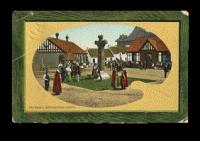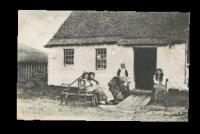‘Irish village’ exhibition postcards
Published in 18th–19th - Century History, Book Reviews, General, Issue 3 (May/June 2011), Letters, Volume 19 Sir,—Stephanie Rains’ excellent article on ‘The politics of “native” village exhibitions’ (HI 19.2, March/April 2011) prompted me to look again at some old Edwardian postcards that I inherited many years ago. Some, which I have reproduced elsewhere (‘Irish International Exhibition’, in Journal of the Royal Society of Antiquaries of Ireland, Vol. 137, pp 149–52), are of the Irish International Exhibition of 1907, which was held on the site of what is now Herbert Park in Ballsbridge.The two depicted here, which have not been reproduced before, relate to the Franco-British Exhibition, which was held in London in 1908, and the Imperial International Exhibition of 1909. The first (in black and white) depicts a group of ‘colleens’ outside a thatched cottage in ‘The Irish Village’, while the second (in colour) depicts a group of villagers on ‘The Square, Ballymaclinton, London’. At the centre of the ‘Square’ is the Celtic [high] cross referred to in Ms Rains’ article. Given that the soap
Sir,—Stephanie Rains’ excellent article on ‘The politics of “native” village exhibitions’ (HI 19.2, March/April 2011) prompted me to look again at some old Edwardian postcards that I inherited many years ago. Some, which I have reproduced elsewhere (‘Irish International Exhibition’, in Journal of the Royal Society of Antiquaries of Ireland, Vol. 137, pp 149–52), are of the Irish International Exhibition of 1907, which was held on the site of what is now Herbert Park in Ballsbridge.The two depicted here, which have not been reproduced before, relate to the Franco-British Exhibition, which was held in London in 1908, and the Imperial International Exhibition of 1909. The first (in black and white) depicts a group of ‘colleens’ outside a thatched cottage in ‘The Irish Village’, while the second (in colour) depicts a group of villagers on ‘The Square, Ballymaclinton, London’. At the centre of the ‘Square’ is the Celtic [high] cross referred to in Ms Rains’ article. Given that the soap

company concerned was based in Donaghmore, Co. Tyrone, it is hardly surprising that the model of a cross depicted is the one that still stands in that village today, with its distinctive broken circle head. The cross is of sandstone and, according to Peter Harbison, is made up of the shaft and head of two separate crosses.Both postcards were addressed to a ‘Miss [Brigid] Byrne’, who may have been from Johnstown, Co. Kildare, but who, at the time, seems to have been in service to a Colonel Norman, who lived in Kensington Court Gardens, London. She seems to have travelled quite extensively with the colonel (and, presumably, his family), as some of the cards were sent to her at Dieppe and Aix-les-Bains in France, as well as Geneva in Switzerland. The 1908 card, for example, is postmarked ‘Kensington W[est]’ and is addressed to ‘Miss Byrne, c/o Col. Norman, Hotel de Paris, Dieppe, France’. The other is postmarked ‘Imperial International Exhibition’ and is addressed to ‘Miss Byrne, Maritinus, Blackrock, Dublin, Ireland’. Based on the content of these types of postcards, one can only agree with Ms Rains’ overall conclusion that the idealised versions of such ‘villages’ featured in these exhibitions were, most likely, driven by the general enthusiasm and nostalgia of the Edwardian era for ‘unspoilt’ rural life, villages and crafts, which had already largely disappeared by then.—Yours etc.,BRIAN McCABENaas
















